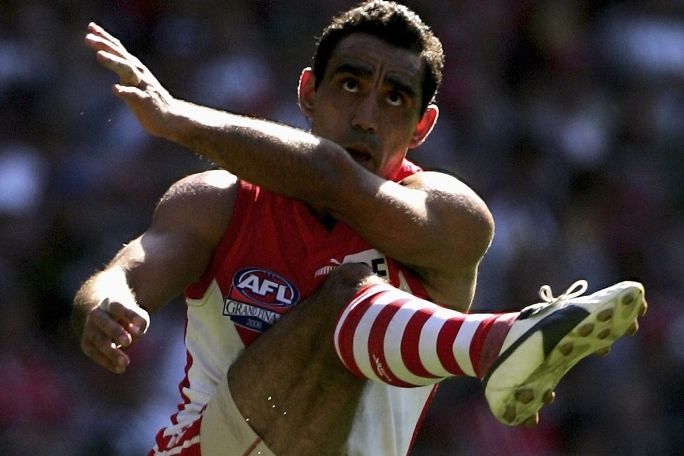Lesson summary
Retired AFL star Adam Goodes is known to many for his resilient journey in the face of detrimental treatment by AFL spectators and the media beginning in 2013.
In this lesson, students explore the benefits of participation in sports and consider how the treatment of Adam Goodes restricted his participation and led to his retirement. Through further inquiry into the spectator and media actions and impacts, students consider the rules and boundaries that are broken when people engage in racist behaviour, especially when that behaviour goes unchallenged.
Students view excerpts from the acclaimed 2019 documentary The Final Quarter as a starting point to brainstorm health, safety, and wellbeing in the context of sport, school, and life. Students consider the impact of racist behaviour on wellbeing.
Learning intentions:
Students will...
- the factors that contribute to community and individual health, safety and wellbeing
- the effects of racism on individuals and groups in their community
- how to establish and extend relationships of mutual trust and respect that are free of racism and that maintain the rights and dignity of all people.
Success criteria:
Students can...
- identify factors that contribute to their individual health, safety and wellbeing and that of the community
- identify links between racism and reduction in individual and community health, safety and wellbeing
- link concepts of respect and dignity to fairness in sport.
Lesson guides and printables
Curriculum links
Select your curriculum from the options below.
Lesson details
Curriculum mapping
Australian curriculum content descriptions:
Year 7 & 8 Health and Physical Education
- Analyse factors that influence emotions, and develop strategies to demonstrate empathy and sensitivity (ACPPS075)
- Evaluate health information and communicate their own and others’ health concerns (ACPPS076)
- Investigate the benefits to individuals and communities of valuing diversity and promoting inclusivity (ACPPS079)
Syllabus outcomes: PDHPE4.3, PDHPE4.8, PDHPE4.11, PDHPE4.13, PDHPE4.16
General capabilities: Critical and creative thinking, Personal and Social Capability, Literacy, Ethical Understanding, Intercultural Understanding
Cross-curriculum priority: Aboriginal and Torres Strait Islander History and Cultures (OI.6, OI.9)
Relevant parts of Year 7 & 8 achievement standards:
Students evaluate the impact on wellbeing of relationships and valuing diversity. They analyse factors that influence emotional responses. They investigate strategies and practices that enhance their own, others’ and community health, safety and wellbeing.
Students apply personal and social skills to establish and maintain respectful relationships and promote safety, fair play and inclusivity. They demonstrate skills to make informed decisions and propose and implement actions that promote their own and others’ health, safety and wellbeing.
This lesson is part of the wider unit of work The Final Quarter – Racism and Responsibility – Years 7 & 8.
Time required: 80 mins.
Level of teacher scaffolding: High – facilitate class discussion with sensitivity to students’ feelings and experience (in relation to racial discrimination).
Resources required
- Butchers’ paper, markers, sticky notes
- Device capable of presenting a video to the class
- Different Forms Of Racism – one copy per student
- Handling Sensitive Topics and Issues (optional)
- Racism Vocabulary (optional)
- Soft small football or other soft ball
- Student Worksheets – one copy per student
Skills
This lesson is designed to build students’ competencies in the following skills:
- Communication
- Critical thinking
- Cultural understanding
- Empathy
- Ethical understanding
- Social skills
Additional info
Using only archival footage aired at the time, The Final Quarter holds a mirror to Australia and is an opportunity to reconsider what happened on and off the football field. Learn more about the film here.
We highly recommend that students view the film in its entirety before participating in subsequent lessons.
Our Watching the Film lessons are designed to support you in facilitating this process. Given the content, it is also important for teachers to communicate with parents and guardians of Aboriginal and Torres Strait Islander students before playing the film and/or engaging with the teaching and learning resources.
Note: This film may not be suitable for viewing by all young people. Teachers are advised to use their discretion when deciding whether to show this film. If teaching in a context with a high proportion of Aboriginal and Torres Strait Islander children, it is imperative that guidance is sought from the Principal and Aboriginal Education Officer (or equivalent) prior to screening the film.


Welcome back!
Don't have an account yet?
Log in with:
Create your free Cool.org account.
Many of our resources are free, with an option to upgrade to Cool+ for premium content.
Already have an account?
Sign up with:
By signing up you accept Cool.org's Terms and Conditions(Opens in new tab) and Privacy Policy(Opens in new tab).